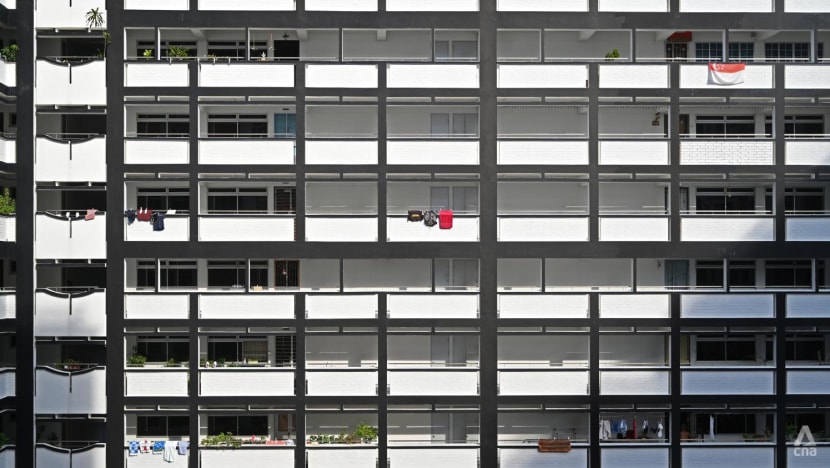Tightened property loan criteria 'timely, well-calibrated'; will instil buyer 'discipline', say analysts
The loan-to-value limit for HDB loans has been lowered from 85 per cent to 80 per cent, while property loans from private financial institutions will see an increase in medium-term interest rate floor by 0.5 per cent.

Housing Board flats in Singapore. (File photo: CNA/Gaya Chandramohan)
SINGAPORE: Tightened housing loan limits will help homeowners exercise prudence in their purchases amid rising interest rates and cost of living, said analysts on Friday (Sep 30).
The adjustments are part of a latest slew of property cooling measures unveiled by Singapore Government on Thursday and kicking in the next day.
They include a 15-month wait-out period for private homeowners buying Housing Board resale flats, in order to moderate demand in the market.
WHAT ARE THE CHANGES TO LOANS?
For HDB loans, the loan-to-value (LTV) limit has been lowered from 85 per cent to 80 per cent.
For property loans from private financial institutions, the medium-term interest rate floor - used to compute total debt servicing ratio (TDSR) and mortgage servicing ratio (MSR) - has been raised by 0.5 per cent.
Residential property purchase loans and mortgage equity withdrawal loans will now have a higher floor of 4 per cent per annum, or the thereafter interest rate.
The thereafter interest rate refers to the highest possible interest rate applicable during the tenure of a property loan, excluding introductory or promotional rates.
TDSR, meanwhile, refers to the portion of a borrower’s gross monthly income that goes towards repaying monthly debt obligations - including the loan being applied for - while MSR is applicable to loans for HDB flats.
By raising the medium-term interest rate floor, authorities are tightening the criteria to assess a borrower's ability to repay the loan.
This will apply to property loans where the option to purchase is granted on or after Sep 30.
WHY ARE THE CHANGES NECESSARY?
That people are forking out "eye-watering" amounts for public housing was a key consideration in implementing the new measures, noted Christine Sun, senior vice-president of research and analytics at real estate agency OrangeTee & Tie.
With more flats across the island fetching record prices and more transactions crossing S$800,000, some buyers may already be overstretching their finances, she added.
"The adjustment of the MSR will have an impact on buyers' housing affordability. With more stringent TDSR and MSR, buyers will have to pay more cash as they can only take fewer loans," said Ms Sun.
"This will have a knock-on effect on moderating housing demand and the pace of price growth."
Mohan Sandrasegeran, senior analyst of research and content creation at One Global Group, said the stricter loan limits represent a "proactive" approach to ensure the impact of borrowing costs for home purchases are taken into consideration for the long-term.
It also takes into account further increases in interest rates, influenced by global market movements, he said.
"The further tightening of the loan quantum limits for HDB housing loans will encourage greater financial prudence among buyers," said Mr Sandrasegeran.
"It is crucial to maintain a check and balance through these measures in order to reduce excessive price increases and 'overheating' in the public housing market."
Catherine He, director and head of research for Singapore at Colliers, said that amid the "double whammy" of a steep rise in interest rates and higher cost of living, the new measures are "timely and well-calibrated" and will "instil discipline and prevent buyers from overleveraging".
She believes the adjustments to loan limits also protects a public who might be unaware that an impending era of higher interest rates will be "very different" from the long period of low interest rates enjoyed from 2013 to 2021.
This will have a "sizeable" impact on their finances should they overextend on housing loans, Ms He warned.
"This adjustment is also necessary, as with three-month SORA (Singapore Overnight Rate Average) nearing 2 per cent and mortgage rates around 3 per cent, it is likely the previous floor of 3.5 per cent for residential and 4.5 per cent for non-residential properties will soon be breached," she added.
HOW ARE PRIVATE PROPERTY BUYERS AFFECTED?
On how the revised loan limits will affect the private residential market, CBRE's head of research for Southeast Asia Tricia Song, noted that the increase in interest rate floor for TDSR was "widely expected and not a surprise".
"Interest rates have been rising and most fixed-rate mortgage packages have exceeded 3 per cent," she explained.
"Based on our calculations, assuming a 20- and 30-year loan term, a 0.5 percentage point increase of interest rate floor for TDSR will reduce the maximum allowable loan and property price by 4.3 and 5.9 per cent respectively, regardless of LTV levels and income."
Analysts also illustrated how the loans would affect different individuals depending on their income.
For the private property market where S$2 million home price quantums are "increasingly common", affordability will "undoubtedly" be impacted - even in the suburban segment, said Lam Chern Woon, head of research and consulting at Edmund Tie.
Mr Lam outlined how a S$1.5 million loan with a 30-year tenure would now require a higher monthly income of about S$13,000 compared to S$12,200 previously. This assumes the individual has no other debt obligations.
"Meanwhile, a household with a monthly income of about S$12,200 would now only be eligible for up to S$1.41 million loan to support a S$1.88 million property purchase, compared to S$2 million previously," he added.
With the TDSR calculation now using a 4 per cent interest rate, the maximum loan for borrowers with a S$10,000 household income on a 30-year loan tenure will be reduced from S$1.23 million to S$1.15 million, added OrangeTee & Tie's Ms Sun.
"Therefore, a buyer can only purchase a property up to a value of S$1.53 million instead of S$1.63 million, without an additional cash outlay."
Colliers' Ms He expects many buyers to be priced out of the market by the rise of the medium-term interest floor rate by 0.5 per cent, as wages are "sticky and unlikely to be adjusted quickly" despite the rising cost of living.
"For example, assuming there are no other loan obligations, (an increase in) monthly income of up to S$1,032 is needed if a buyer wants to take up a S$2 million loan for a residential property after the adjustment. Or the loan amount will have to be reduced," she said.
IMPACT ON PROPERTY MARKET
The new cooling measures will have "minimal impact" on private residential sales in the immediate term, since there is no adjustment to the LTV for bank loans, said Dr Tan Tee Khoon, country manager for PropertyGuru Singapore.
"Furthermore, lenders have already been exercising prudence in offering loans and have taken into account higher interest rates in repayments," he added.
"However, there may be some knee-jerk reaction by buyers to recalibrate their purchase options.
"We anticipate that prospective buyers will likely take longer to commit to home purchases, translating to a slowdown in sales as the negotiation of prices and matching of buyers takes longer."
As for the impact of the cooling measures in the middle to long term, they are "likely to be dwarfed by future volatile global economic conditions", said Dr Tan.
"Higher interest rate hikes and recessionary pressure will lead to more caution in discretionary spending and purchasing of homes," he said.
"Separately, the measures may inject confidence among foreign buyers with strong wealth preservation motives that the Singapore residential market will be on a sustainable path of growth."
Ultimately, it is important to remember the cooling measures are intended to "introduce prudence to every segment of the market", especially since Singapore's interest rates are pegged to the United States' Federal Reserve rates, said Edmund Tie CEO Desmond Sim.
The latest hike of 0.75 per cent for the US central bank's rates, in order to tame inflation, has "significantly" impacted mortgage interest rates in Singapore, he noted.
"In layman's terms, it's like previously, you needed to be 1.3m to sit a rollercoaster. So now, they just changed it to 1.35m," said Mr Sim.
"Because of (the hike in US Fed rates), it means the rollercoaster ride has gotten more dangerous. So we need to basically have a higher height limit to make sure that safety is ensured.
"In the spirit of F1 happening this weekend - this would be like if the safety car is deployed."

















